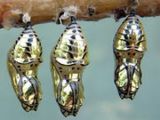It's like any normal culture in which for an abundant and healthy crop you have to be careful against furtive predators like insects, spiders and birds.
This way, the product with the most beautifully colored wings on Earth will be achieved at thousands of km away from its origins. Butterfly growing is a commercial activity which is an ingenious, nice and ecological way of contributing to the preservation of many butterfly species.
For centuries, the Chinese have grown moths to supply the silk industry. But day butterflies are grown since recent times.
During the '70s an exhibition of living exemplars was held in Guernsey (off England). The organizers wanted to recreate a tropical forest full of colorful butterflies.
But most tropical species have short life spans, just two-three weeks, and it was difficult to transport them securely and preserving them healthy for thousands of km. This way the idea of commercially breeding butterflies emerged.
The butterflies are grown in special greenhouses. They are totally closed, to avoid the predators from eating the eggs.
In nature, the survival level of the eggs is 2 %, but in a butterfly farm it's about 90 %.
The greenhouses are full of plants required by specific butterfly species for growing, breeding and sheltering. On some, the females depose their eggs and the caterpillars eat them; others provide flowers for the adults feeding on nectar.
Each butterfly species is specialized in just one plant: its caterpillar will eat only that plant.
A female deposes about 100 eggs, usually in a specific zone of the plant, thus the farmer won't find any difficulty in locating them, collecting them and preserving them.
When the larvae hatch, they are served with the preferred host plant in flowerpots.
The cages where the caterpillars are kept must be maintained clean, otherwise the caterpillars can catch infections and die. From hatching to the maximum size, a caterpillar increases 4,000 times in size!
After the fifth molt, the caterpillar attaches to the cage's ceiling or a branch and detaches its skin, under which a hardened capsule appears, named chrysalis (pupa). The pupas must be collected daily, as only this way their age can be determined.
They are put carefully in carton cages, some 40 to 100 exemplars in each, protected by cotton layers. In some 10 days, the merchandise must reach the clients, mostly butterfly houses and similar institutions. If this is not made at the right time, the butterflies will emerge from the pupas and will die during transportation.
Otherwise, they will face the world at thousands of km from their natal places. Currently, butterfly farms are found in the US, El Salvador, Costa Rica, Philippines, Kenya, Madagascar, Malaysia, Taiwan and Thailand.

 14 DAY TRIAL //
14 DAY TRIAL // 
